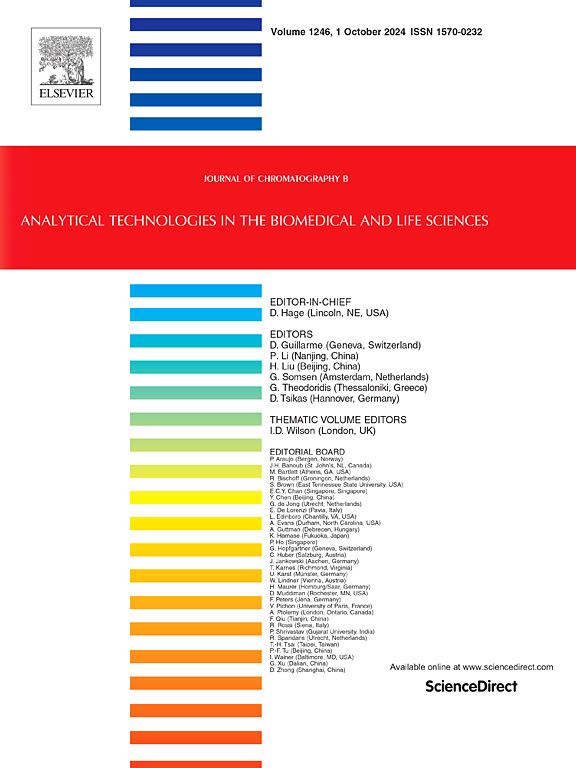整合非靶向和靶向代谢组学,揭示草药HLXLD治疗阿尔茨海默病的机制
IF 2.8
3区 医学
Q2 BIOCHEMICAL RESEARCH METHODS
引用次数: 0
摘要
藿香消灵丹(HLXLD)是一种由11种草药组成的中草药,已被证明可有效缓解阿尔茨海默病(AD)的认知和记忆障碍。然而,潜在的机制需要进一步的研究。本研究旨在从代谢角度阐明HLXLD治疗AD的潜在治疗机制。建立AlCl3和D-gal诱导的AD大鼠模型,采用Morris水迷宫(MWM)实验和海马组织病理学方法评价HLXLD对AD的药理作用。随后,采用uhplc - q - exp - orbitrap - ms对脑组织样本进行非靶向代谢组学分析,并进行多变量统计分析。进一步采用UHPLC-QQQ-MS靶向代谢组学对非靶向代谢组学发现进行验证和补充,涉及神经递质、氨基酸、花生四烯酸和脂质,阐明疾病、草药和代谢途径之间的关系。研究发现,HLXLD可以缓解AD的进展,调节代谢失衡。脑组织中赖氨酸、牛磺酸、富马酸、前列腺素E2、胆碱等26种代谢物水平降低,6种代谢物水平升高,这些代谢物的改变主要与氨基酸代谢、TCA循环、花生四烯酸代谢和脂质代谢有关。靶向代谢组学结果显示,与模型组相比,脑组织中8种神经递质、21种氨基酸、7种花生四烯酸和16种脂质水平发生变化,血浆中9种神经递质、20种氨基酸、6种花生四烯酸和2种脂质水平发生变化。综上所述,HLXLD可通过调节多种代谢途径提高内源性代谢物水平,在AD治疗中发挥能量供应、抗神经炎症和神经保护作用。本文章由计算机程序翻译,如有差异,请以英文原文为准。
Integrated untargeted and targeted metabolomics to reveal the mechanisms of herbal medicine HLXLD on Alzheimer's disease
Huo-Luo-Xiao-Ling-Dan (HLXLD), a Chinese herbal medicine consisting of 11 herbs, has been shown to be effective in alleviating cognitive and memory impairment in Alzheimer's disease (AD). However, the underlying mechanisms require further investigation. This study aimed to clarify potential therapeutic mechanisms of HLXLD in the treatment of AD from a metabolic perspective. A rat model of AD induced by AlCl3 and D-gal was established, the Morris water maze (MWM) test and hippocampal histopathology were used to evaluate the pharmacological effect of the HLXLD on AD. Subsequently, untargeted metabolomics of brain tissues samples was performed by UHPLC-Q-Exactive-Orbitrap-MS, followed by multivariate statistical analysis. Targeted metabolomics by UHPLC-QQQ-MS was further employed to validate and supplement the untargeted metabolomics finding, involving neurotransmitters, amino acids, arachidonic acid and lipids, to elucidate the relationship between disease, herbal medicine and metabolism pathway. The study found that HLXLD could relieve the progression of AD and regulate metabolic imbalances. The levels of 26 metabolites decreased and 6 increased in brain tissues including lysine, taurine, fumaric acid, prostaglandin E2, choline and so on, these altered metabolites were primarily associated with amino acid metabolism, TCA cycle, arachidonic acid metabolism and lipid metabolism. The targeted metabolomics results showed that compared with the model group, the levels of 8 neurotransmitters, 21 amino acids, 7 arachidonic acids and 16 lipids in brain tissue, 9 neurotransmitters, 20 amino acids, 6 arachidonic acids and 2 lipids in plasma were changed. In summary, HLXLD could improve the levels of endogenous metabolites by regulating multiple metabolic pathways and play a role in energy supply, anti-neuroinflammatory and neuroprotective effects in AD treatment.
求助全文
通过发布文献求助,成功后即可免费获取论文全文。
去求助
来源期刊

Journal of Chromatography B
医学-分析化学
CiteScore
5.60
自引率
3.30%
发文量
306
审稿时长
44 days
期刊介绍:
The Journal of Chromatography B publishes papers on developments in separation science relevant to biology and biomedical research including both fundamental advances and applications. Analytical techniques which may be considered include the various facets of chromatography, electrophoresis and related methods, affinity and immunoaffinity-based methodologies, hyphenated and other multi-dimensional techniques, and microanalytical approaches. The journal also considers articles reporting developments in sample preparation, detection techniques including mass spectrometry, and data handling and analysis.
Developments related to preparative separations for the isolation and purification of components of biological systems may be published, including chromatographic and electrophoretic methods, affinity separations, field flow fractionation and other preparative approaches.
Applications to the analysis of biological systems and samples will be considered when the analytical science contains a significant element of novelty, e.g. a new approach to the separation of a compound, novel combination of analytical techniques, or significantly improved analytical performance.
 求助内容:
求助内容: 应助结果提醒方式:
应助结果提醒方式:


